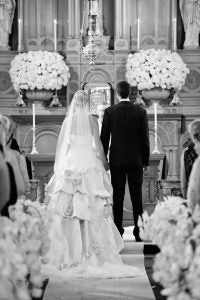Are wedding traditions simply harmless rituals that celebrate the love of two happy people and provide a way to gather all the people in the couple’s life in one place to share in joy? Or do they involve much more?
Fairchild (2014) conducted a study to examine the conventional, American “white wedding” script that dominates wedding markets and representations of weddings in media. Weddings can be highly ritualized with a myriad of cultural ideas condensed into a few hours. Consequently, they provide a unique opportunity to place gender on an elevated plane, allowing the researcher to observe the various ways it operates to convey messages about appropriate social roles as masculinity and femininity are exaggerated.
To investigate how gender operates at weddings, Fairchild (2014) observed eight weddings/commitment ceremonies, including church weddings, weddings performed at home, and wedding in other public locations. She also observed two commitment ceremonies, not accompanied by legal marriages, involving one gay and one heterosexual couple. She conducted in-depth interviews and participant observation so that she could get to know the couples in more detail, to discern how they understood their ceremonies (and weddings in general), and to develop her own interpretations of the events.
The theoretical basis for her research is the relationship among individual, interactional, and institutional dimensions of gender. In other words, what the individual wants, what the people around him/her wants, and what society wants. In order to home in on this relationship, Fairchild (2014) focused on “visibility cues” that reveal the contradictions between the three dimensions. This is when an aspect of the ceremony deviates from the norm, such as having a male bridesmaid. Visibility cues bring to light the boundaries of each of the dimensions and suggest pathways for possible change.
Her findings indicate that gender is “done” in weddings via the performance of rituals that convey messages about what it means to be a man or a woman, and the relationships among men and women. Structure, especially gender at the institutional level, underlies the “doing gender” perspective as it restricts a couple’s understandings and decisions as they plan their wedding.
Fairchild, Emily. 2013. “Examining Wedding Rituals through a Multidimensional Gender Lens.” Journal of Contemporary Ethnography43(3):361–89.
